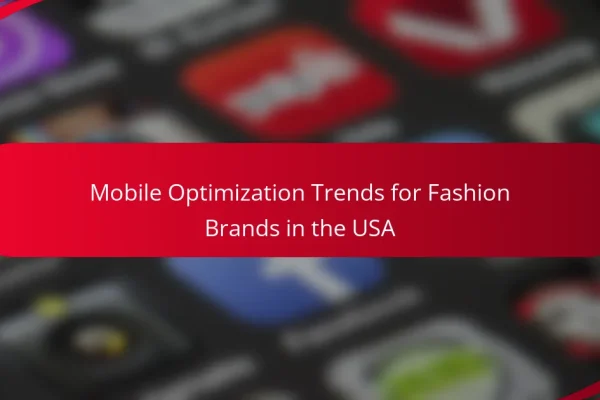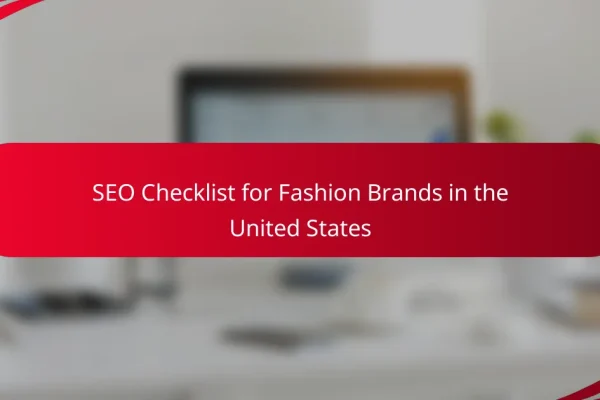What are effective SEO strategies for fashion brands in the USA?
Effective SEO strategies for fashion brands in the USA focus on enhancing online visibility and attracting targeted traffic. Key approaches include optimizing website content, leveraging social media, and implementing local SEO tactics to connect with consumers in specific regions.
On-page optimization techniques
On-page optimization is crucial for fashion brands to improve search engine rankings. This includes optimizing title tags, meta descriptions, and header tags with relevant keywords that reflect the brand’s offerings. Additionally, using high-quality images with descriptive alt text can enhance visibility in image searches.
Ensure that the website’s loading speed is fast, ideally under three seconds, as this impacts user experience and search rankings. Regularly updating content and maintaining a clear site structure also contribute to better SEO performance.
Content marketing for brand visibility
Content marketing plays a vital role in increasing brand visibility for fashion brands. Creating engaging blog posts, style guides, and lookbooks can attract potential customers and establish the brand as an authority in the fashion industry. Incorporating relevant keywords naturally into this content is essential for SEO.
Consider utilizing video content, such as fashion tutorials or behind-the-scenes footage, as videos can significantly boost engagement and shareability. Regularly sharing content on the brand’s website and through email newsletters can help maintain audience interest and drive traffic.
Utilizing social media for SEO
Social media platforms are powerful tools for enhancing SEO for fashion brands. By sharing high-quality content and engaging with followers, brands can increase their online presence and drive traffic to their websites. Platforms like Instagram and Pinterest are particularly effective for fashion due to their visual nature.
Incorporate relevant hashtags and encourage user-generated content to expand reach. Collaborating with influencers can also enhance visibility and credibility, leading to increased website visits and improved search rankings.
Mobile optimization for fashion websites
Mobile optimization is essential for fashion brands, as a significant portion of online shopping occurs on mobile devices. Ensure that the website is responsive, meaning it adjusts seamlessly to different screen sizes. Fast loading times and easy navigation are critical for retaining mobile users.
Implementing mobile-friendly features, such as click-to-call buttons and simplified checkout processes, can enhance user experience. Google prioritizes mobile-friendly sites in search rankings, making this a crucial aspect of SEO strategy.
Local SEO tactics for fashion retailers
Local SEO is vital for fashion retailers looking to attract customers in specific geographic areas. Claiming and optimizing Google My Business listings can enhance visibility in local search results. Include accurate business information, such as address, phone number, and operating hours.
Encourage satisfied customers to leave positive reviews, as these can significantly influence local search rankings. Additionally, participating in local events or collaborations can boost community engagement and improve local search visibility.
How can fashion brands improve their keyword targeting?
Fashion brands can enhance their keyword targeting by focusing on specific phrases that potential customers are likely to use when searching for products. This involves understanding customer intent and aligning content with relevant keywords that drive traffic and conversions.
Long-tail keyword strategies
Long-tail keywords are phrases that are more specific and typically longer than standard keywords. They often have lower search volume but higher conversion rates because they target users further along in the buying process. For example, instead of targeting “shoes,” a brand might focus on “women’s running shoes for flat feet.”
To implement long-tail strategies, brands should conduct thorough keyword research using tools like Google Keyword Planner or SEMrush. Aim for phrases that reflect niche markets or specific customer needs, as these can lead to more qualified traffic.
Competitor keyword analysis
Analyzing competitor keywords helps brands identify gaps and opportunities in their own keyword strategies. By examining which keywords competitors rank for, brands can discover new terms to target or refine their existing content. Tools like Ahrefs or Moz can provide insights into competitor keyword performance.
When conducting competitor analysis, focus on both high-ranking keywords and those with lower competition. This dual approach allows brands to target popular terms while also capitalizing on less saturated keywords that may yield quicker results.
Using Google Trends for fashion keywords
Google Trends is a valuable tool for fashion brands to track the popularity of specific keywords over time. By entering relevant terms, brands can see how interest fluctuates and identify seasonal trends, which is crucial for planning marketing campaigns.
When using Google Trends, look for rising queries related to your niche and consider incorporating these into your content strategy. This can help brands stay ahead of trends and ensure that their keyword targeting aligns with current consumer interests.
What role does content play in fashion brand SEO?
Content is crucial for fashion brand SEO as it enhances visibility, engages audiences, and builds brand authority. High-quality, relevant content helps search engines understand your brand and improves your chances of ranking higher in search results.
Blogging for audience engagement
Blogging is an effective way to engage your audience by providing valuable insights, style tips, and trends. Regularly updated blog posts can attract visitors to your site, encouraging them to explore your products and services.
To maximize engagement, focus on topics that resonate with your target demographic. Use a mix of how-to guides, seasonal trends, and behind-the-scenes content to keep your audience interested and returning for more.
Video content for brand storytelling
Video content allows fashion brands to tell their stories in a dynamic and visually appealing way. This format can showcase products in action, highlight brand values, and connect emotionally with viewers.
Consider creating short videos for social media platforms like Instagram and TikTok, as these can significantly increase engagement. Aim for videos that are concise, visually striking, and shareable to maximize reach.
Influencer collaborations for content reach
Collaborating with influencers can expand your content reach and introduce your brand to new audiences. Influencers often have dedicated followings that trust their recommendations, making them valuable partners for promoting your products.
When selecting influencers, look for those whose style aligns with your brand and who engage authentically with their followers. This can lead to more genuine content and better results for your SEO efforts.
How can fashion brands leverage backlinks?
Fashion brands can leverage backlinks by building relationships with relevant websites and influencers to enhance their online authority and visibility. High-quality backlinks from reputable sources improve search engine rankings and drive targeted traffic to their sites.
Building relationships with fashion bloggers
Establishing connections with fashion bloggers is crucial for gaining valuable backlinks. Brands should identify bloggers who align with their target audience and engage with them through social media, comments, or direct outreach.
Offering exclusive content, product samples, or collaborations can incentivize bloggers to feature the brand and link back to their website. This mutual benefit fosters long-term relationships that can lead to consistent backlink opportunities.
Guest posting on fashion websites
Guest posting on established fashion websites is an effective strategy for acquiring backlinks. Brands can contribute articles that showcase their expertise or unique perspectives, ensuring the content is relevant to the host site’s audience.
When selecting sites for guest posts, focus on those with high domain authority and a strong readership. Include a link back to the brand’s website within the author bio or the article itself, adhering to the host’s guidelines for backlinks.
Utilizing PR for link building
Public relations (PR) can significantly enhance a fashion brand’s backlink profile. By crafting compelling press releases about new product launches, events, or collaborations, brands can attract media coverage that includes backlinks to their site.
Engaging with journalists and media outlets that cover fashion can lead to features in articles, blogs, or news segments. Brands should maintain a media list and regularly pitch story ideas that highlight their unique offerings and industry relevance.
What are the best tools for fashion brand SEO analysis?
The best tools for fashion brand SEO analysis include SEMrush, Ahrefs, and Google Analytics. These platforms provide essential insights into keyword performance, backlink profiles, and overall website traffic, helping brands optimize their online presence effectively.
SEMrush for keyword research
SEMrush is a powerful tool for keyword research, allowing fashion brands to identify high-traffic keywords relevant to their niche. Users can analyze search volume, keyword difficulty, and trends to prioritize their SEO efforts.
To maximize its effectiveness, brands should focus on long-tail keywords that reflect specific fashion items or styles. This approach often leads to higher conversion rates as these terms attract more targeted traffic.
Ahrefs for backlink analysis
Ahrefs excels in backlink analysis, providing insights into the quality and quantity of links pointing to a fashion brand’s website. Understanding the backlink profile is crucial for improving domain authority and search rankings.
Brands should regularly monitor their backlinks and aim to acquire links from reputable fashion-related websites. A diverse backlink profile can significantly enhance visibility in search engine results.
Google Analytics for performance tracking
Google Analytics is essential for tracking website performance, offering detailed insights into user behavior and traffic sources. Fashion brands can use this data to assess the effectiveness of their SEO strategies and make informed adjustments.
Key metrics to monitor include organic traffic, bounce rates, and conversion rates. By analyzing these figures, brands can identify successful content and areas needing improvement, ensuring continuous growth in their online presence.
How can fashion brands measure SEO success?
Fashion brands can measure SEO success through various metrics, including organic traffic, keyword rankings, and conversion rates. By analyzing these factors, brands can assess the effectiveness of their SEO strategies and make necessary adjustments.
Key performance indicators for SEO
Key performance indicators (KPIs) for SEO include organic search traffic, bounce rate, and average session duration. Organic search traffic indicates how many visitors arrive from search engines, while bounce rate measures the percentage of visitors who leave after viewing only one page. Average session duration reflects how long visitors stay on the site, providing insights into engagement levels.
Brands should track these KPIs regularly using tools like Google Analytics and Google Search Console. Setting benchmarks based on historical data can help identify trends and areas for improvement.
Tools to track SEO performance
Several tools can assist fashion brands in tracking SEO performance effectively. Google Analytics provides comprehensive data on website traffic and user behavior, while Google Search Console offers insights into search visibility and indexing issues. Other tools like SEMrush and Ahrefs can help monitor keyword rankings and backlinks.
Using a combination of these tools can give a well-rounded view of SEO performance. Brands should choose tools that align with their specific goals and budget, ensuring they gather relevant data for informed decision-making.
Adjusting strategies based on performance data
Adjusting SEO strategies based on performance data is crucial for continuous improvement. If organic traffic is declining, brands should investigate potential issues such as content quality or technical SEO problems. Regularly updating content and optimizing for relevant keywords can help regain lost traffic.
Additionally, brands should conduct A/B testing on different elements, such as headlines and call-to-action buttons, to determine what resonates best with their audience. This iterative approach allows for data-driven decisions that enhance overall SEO effectiveness.















